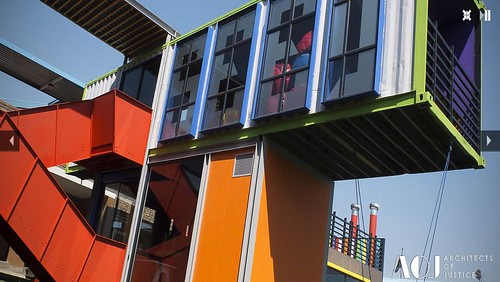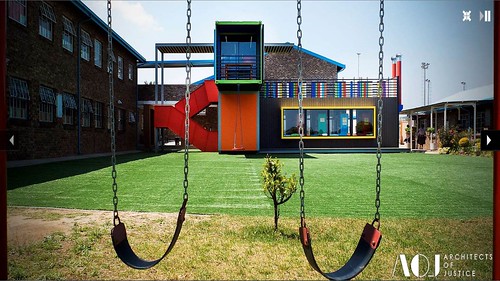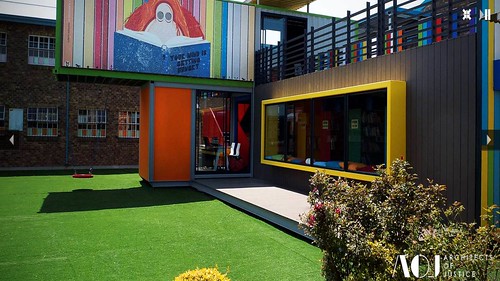Reconceiving the elementary school library in Johannesburg

Posted January 21, 2014 at 1:29PM
Now THIS is an exciting example of People Habitat: The South African firm Architects of Justice has designed a remarkable new school library for one of that country's most historically troubled townships. In so doing, the firm has established an inspirational and replicable model that can be efficiently built for other schools across South Africa. From the photographs, it’s an exciting facility that kids and adults alike should love.
Improving schools in South Africa's townships is important. During apartheid, the townships were constructed on the edge of cities as places for nonwhites to live. They were and remain typically poor and plagued by conflict.
Alexandra Township, or Alex as it is informally known, is on the outskirts of Johannesburg in the Gauteng province. It has seen a number of periods of strife and violence over the decades, along with several plans for urban renewal, none of which has succeeded. Alexandra has a population of around 180,000, including a large number living in informal housing similar to the favelas in Brazil.
I first learned of the colorful new library located at Alexandra’s MC Weiler Primary School through an article posted on the Sustainable Cities Collective by the nonprofit think tank Future Cape Town. I decided to research the project’s history and learned that, according to the publication South African Homeowner, the library was commissioned in 2010 by the MAL foundation, South Africa’s first non-profit creative agency. It was to be a world-class facility that could be used as a blueprint for future libraries in South African schools.
Architects of Justice called the project SEED, metaphorically for the “germination of knowledge,” and literally for “Supplementary Extended Education Device.” The firm originally designed a larger, more comprehensive facility for the school with not only places for books but also spaces for audio books, study and classrooms, a multi-media center, indoor and outdoor group amphitheater spaces, and outdoor spaces for learners to escape and read a book. The full design proved too expensive to implement, however, forcing the architects to rethink the concept. The award-winning design that emerged from this challenge produced a “semi-permanent” facility to be built from the highly creative application of two shipping containers.
The genius of the plan is that the library, which is placed within a school courtyard, is designed to attract kids while serving as an inspiration for learning. While I find the exterior of the Weiler School somewhat drab, the new library is anything but.
Architects of Justice, a three-person firm with idealism at the core of its practice, emphasizes that the team was aiming for far more than an ordinary facility. From the firm’s response to questions posed by South African Homeowner:
“An exploration into other examples of prefabricated libraries in South Africa will reveal that they are dull, unimaginative ‘prisons for books’ in which the love for reading cannot possibly be fostered. To paraphrase the MAL Foundation, the SEED is a glowing tribute to contemporary container design, where fertile young minds can get a colorful dynamic blast of creativity to fuel their imaginations instead of the usual dour grey boxed-in dross that gets handed down. It is the Architects Of Justice’s opinion that, although the SEED is somewhat more expensive than other local prefabricated libraries, buildings like it can be a justified investment in our country as we need to move past trying to fix our problems of literacy with quick, cheap solutions which become prisons for information and, rather, create places and buildings that are depositories of knowledge that stimulate learning and growth.”
The containers are not stacked directly on top of one another but rather at a ninety-degree angle, creating a cross when viewed from above. The ground floor houses the book library and the upper floor houses spaces for group work and individual study. On the roof of the ground floor is an outdoor reading deck that is accessed from the upper floor. There is also a deck on the ground floor which doubles as a stage for school assemblies.
The Gauteng Institute for Architecture, which last year bestowed one of its annual Merit awards on the library’s design, was impressed:
“The building cleverly maximizes its space constraints while still managing to accommodate all the core necessities of a school library. It is a place to access information, a place in which to do homework and a place to read. SEED is a magical children’s toy box, and it is a working illustration that a library can be an exciting and stimulating place. Through the playful application of bright colors, through its shape, through its use of light and through activating the adjacent outdoor courtyard it captures one’s attention and invites the user to make use of its facilities. I t has become a beacon of knowledge and hope to local children, most of whom live in the surrounding impoverished neighborhood . . .
“SEED demonstrates the power of architecture as an agent for social change. To quote the client, ‘fertile young township minds get with SEED a colorful and dynamic blast of creativity to fuel their imagination.’ This is a prototype which can be rolled out at many other township schools. Imagine how bright we can make the future with more such buildings?”
The library is designed to be removable and placed at another school if funding is found to construct the more advanced design originally conceived. Architects of Justice is based in Johannesburg.
Related posts:
- Apartheid and its aftermath, represented in the story of one very tall apartment building (November 7, 2013)
- Stabilizing & greening the favelas: Rio's formidable challenge (October 21, 2013)
- Shipping container "cities" bring creative, funky approach to green construction (May 11, 2012)
- Recycled land and shipping containers make a lively city market (August 8, 2011)
Move your cursor over the images for credit information.






